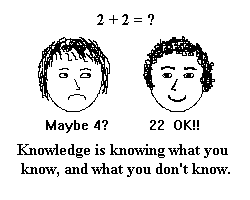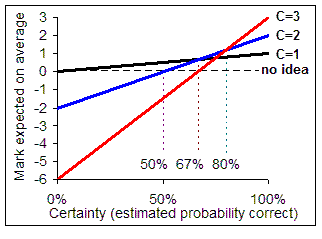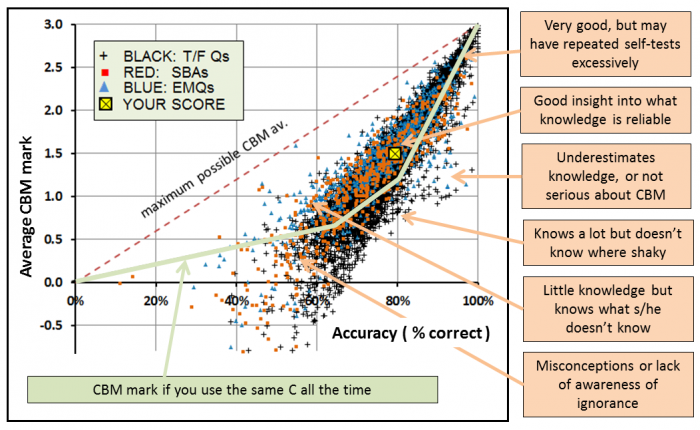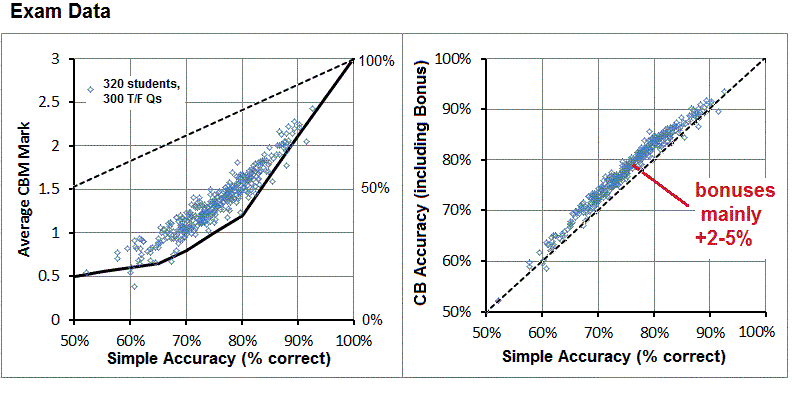Using certainty-based marking: Difference between revisions
No edit summary |
No edit summary |
||
| Line 1: | Line 1: | ||
{{Quiz}} | {{Quiz}} | ||
'''Note:''' CBM in Moodle is based on strategies developed by Prof. Gardner-Medwin at UCL (London, UK). More | '''Note:''' CBM in Moodle is based on strategies developed by Prof. Gardner-Medwin at UCL (London, UK). More documentation can be sourced [http://www.ucl.ac.uk/lapt here]. | ||
=What is Certainty-Based marking (CBM)?= | =What is Certainty-Based marking (CBM)?= | ||
| Line 109: | Line 109: | ||
*A basic CBM interface has been present in core code since v2.1, but it is advisable to use the [http://www.TMedwin.net/cbm/moodle/index.htm patches] described above if Moodle is to give constructive feedback to students prior to v2.6. | *A basic CBM interface has been present in core code since v2.1, but it is advisable to use the [http://www.TMedwin.net/cbm/moodle/index.htm patches] described above if Moodle is to give constructive feedback to students prior to v2.6. | ||
For more information on scores | For more information on scores see [http://www.ucl.ac.uk/lapt/moodle/cbm/cbmscores.htm Self test scores with and without CBM] | ||
<br>ARGM Dec 2013. [http://www.ucl.ac.uk/~ucgbarg/pubteach.htm Publications]. | <br>ARGM Dec 2013. [http://www.ucl.ac.uk/~ucgbarg/pubteach.htm Publications]. | ||
[[es:Puntuación Basada en Certeza]] | [[es:Puntuación Basada en Certeza]] | ||
Revision as of 12:06, 16 December 2013
Note: CBM in Moodle is based on strategies developed by Prof. Gardner-Medwin at UCL (London, UK). More documentation can be sourced here.
What is Certainty-Based marking (CBM)?
- After each answer, you say how sure you are that your answer is correct.
- This is on a 3-point scale: C=1 (low), C=2 (mid) or C=3 (high)
- We don't rely on words like 'sure' or 'very sure' because these mean different things to different people
- The mark scheme and the risk of a penalty determine when you should use each C level:
| Certainty level | C=1 | C=2 | C=3 | No Response or 'No Idea' |
|---|---|---|---|---|
| Mark if correct | 1 | 2 | 3 | ( 0 ) |
| Mark if wrong | 0 | -2 | -6 | ( 0 ) |
| Probability correct | < 67% | 67–80% | >80% | - |
| Description | Unsure | Mid | Quite sure | - |
- Certainty levels 1, 2, 3 always give you marks 1, 2, or 3 when you are correct
- If you are wrong, then unless you opted for C=1 you will lose marks: -2 at C=2 and -6 at C=3
Why use CBM?
- To make students think about how reliable their answer is.
- To encourage students to try to understand the issues, not just react immediately to a question.
- To challenge: if a student won't risk losing marks if wrong then they don't really know the answer.
- If a student is a careful thinker but not very confident. they will gain in confidence.
- It is more fair - a thoughtful and confident correct answer deserves more marks than a lucky hunch.
- Students need to pay attention if they make confident wrong answers: think, reflect, learn!
- Efficient study requires constantly questioning how our ideas arise and how reliable they are.

How to decide on the best certainty level
- If you're sure, obviously you do best with C=3. But you will lose twice over (-6) if you are actually wrong!
- If unsure, you should avoid any risk of penalty by choosing C=1
- In between, you are best to use C=2: you gain 2 or lose 2 depending on whether you are right.

- The graph shows how the average mark at each C level depends on the probability that your answer will be right.
- Suppose you think you only have a 50% chance of being right: The highest graph for 50% on the bottom scale is black (for C=1). So you will expect to boost your marks on average most by acknowledging your low certainty (C=1).
- If you think you can justify your answer well, with more than an 80% chance of being correct, then the red graph is highest, for C=3. Opt for this.
- Note that you can't ever expect to gain by misrepresenting your certainty. If you click C=3 (the red line) when you aren't sure, you will expect to do badly - with very likely a negative mark. You might be lucky; but on average you will lose! If you understand the topic well, and think your answer is reliable, then you will lose if you opt for C=1 or C=2 rather than C=3. You will do best if you can distinguish which answers are reliable and which uncertain.
Feedback about your CBM performance
- If you are using CBM with feedback given after each answer, then the mark tells you a lot: -6 will make you ask how you justified confidence in a wrong answer. Think (along with any available explanations and your books or notes) how to tie together different bits of your knowledge.
- If you repeatedly get answers right with C=1 then ask yourself if perhaps you know the subject better than you think. Ask how you might relate your answers to things that you definitely do know and are more confident about.
- When you finally submit, you will see your percentages correct for each C level you used. Ideally these might be around 50%,70%,90% for C=1,2,3 whether you know the subject well (lots of answers at C=3) or poorly (lots at C=1). The feedback will warn if you are tending to overestimate or underestimate how reliable your answers are. If overconfident, think about why! Perhaps you were careless; perhaps you have misconceptions, or are giving confident answers to questions you don't really understand or that are phrased ambiguously. Use this to guide your study and to improve your interaction with teachers.
- Note that some questions in a quiz may carry more weight than others, so for example you might get -12 if the question carries double weight and you make a confident error. Since this makes feedback harder to interpret, it probably isn't a good idea for quiz-setters to vary weights in this way when using CBM.
- If you've only answered a few questions, CBM feedback may not mean very much: 2 or 3 unconfident correct answers may just be luck! What is important is that you think about why you were confident or unconfident, and learn from that.
CBM Grades and Scores
Moodle Grade, CBM Average Mark and Accuracy
- The Moodle Grade is the total of marks awarded, scaled relative to a nominal value for the whole quiz. Grades are sometimes shown 'out of' this value, but with CBM the grade can be up to 3 times this value (if all answers are correct at C=3).
- The CBM Average can range between 3 and -6. If all the questions in the quiz have the same weight, then it is simply the average CBM mark, as shown in the CBM table above. If the weights (w) vary, then for CBM marks (m) awarded on each question the CBM Average = Σ(wm)/Σ(w).
- Accuracy is a conventional measure of how much you got right in the quiz, ignoring CBM ratings. If all questions carry equal weight, it is the percentage of answers that were correct (with perhaps some answers being counted as partially correct). If questions have different weights w, and answers have fractional correctness f (between 0 and 1) then Accuracy = Σ(wf)/Σ(w).
- Partially Correct Answers. If Moodle answers are partially correct (assigned a fraction f greater than zero), then for C=1, 2,or 3 the mark awarded will be f, 2f or 3f. If f is negative (implying that any correct portion of a response is outweighed by errors) then the mark awarded will be the same as for a wrong answer (0,-2 or -6).
What do Average CBM marks and Accuracy tell you?
The graph* shows the scores (Accuracy and CBM average) for several thousand online submissions on a variety of voluntary CBM self-tests for learning and revision, mostly with university students.
It is annotated with interpretations of the students' knowledge in different zones of the graph.

- * Format used in CBM Self-Tests (not currently in Moodle) to superimpose a student's score after submission.
- Note that the CBM average is always less, as a percentage of maximum, than accuracy. For the score shown in yellow, the CBM average (1.5) was 50% of maximum, while the accuracy (which ignores C ratings) was 80%. You obviously shouldn't worry that your CBM average is less, expressed in this way, than your conventional score. It always is!
- If you didn't discriminate at all between reliable and uncertain answers (giving them all the same C rating, appropriate just for how well you know the topics on average), then your scores would lie somewhere on the green line on the graph.
- If your score lies above the green line, then you are successfully distinguishing reliable answers from uncertain ones. If your score lies below, then you are either misjudging how well you know and understand the topics, or you may have serious misconceptions (things you confidently believe, but that are not so!).
CBM Bonus and enhanced 'Accuracy + Bonus'
It is convenient to express a student's ability to distinguish reliable from uncertain knowledge (as shown on the graph above) by adjusting conventional 'accuracy' with the addition of a simple bonus. The CBM Bonus is proportional to the amount the CBM average lies above the green line on the graph. The bonus is negative** if the score lies below the line. For the example score shown in yellow, the CBM average is 0.3 marks above the line, leading to a bonus of +3%. This can be added to the accuracy (=80%) to give Accuracy + CBM Bonus = 83%.
- ** If you think a negative bonus strange, consider the benefits if bankers' bonuses could go negative. A negative CBM bonus typically flags what were described by Confucius as failures "when you do not know a thing, to allow that you do not know it" and by Donald Rumsfeld, more concisely, as "unknown unknowns". They are both essentially negative knowledge, worse than acknowledged ignorance.
- The amount of CBM Bonus is determined by a multiplication factor β used to convert the mark difference to a bonus. A value of β=0.1 is used in Moodle, being both simple and essentially optimal when the resultant score (Accuracy + Bonus) has been judged by its statistical reliability and ability to predict performance on related tests. Ref: Gardner-Medwin, 2013
- Consideration of Accuracy and CBM Bonus, rather than direct CBM grades or average scores, helps examiners to maintain existing standards criteria (typically based on accuracy) while readily seeing the added discrimination between students arising from CBM.

Example CBM data from a UCL medical exam.
CBM is particularly valuable for self-tests, where students challenge themselves as part of their study. Answers may be omitted because they are not on a topic of current interest, they are too easy, or perhaps not yet studied. CBM scores can then be presented relative to the set of questions the student has chosen to respond to. All correct on just half of a quiz would then show as 100% accurate. It is up to the student to interpret such scores: obviously if questions are omitted because they are difficult, then the relative score may overestimate competence in the subject. Moodle 'Grades' are always relative to the whole quiz, and this is the default presentation for other scores too.
CBM available in different Moodle Versions
- CBM with proper feedback to students is available for Moodle 1.9-2.0 & 2.2-2.5, using patches to core code available at http://www.TMedwin.net/cbm/moodle. This means you will have to check which Moodle version you are using, choose the appropriate download and copy the altered files to your server. This process is easy to achieve and reversible. It adds CBM functionality without affecting your existing options, and with no known risks. Follow the instructions on the download site.
- Full CBM functionality was introduced into core code in Moodle 2.6. CBM Grade and score summaries (for teachers) require an additional Quiz Report Plugin: please install this if you use CBM in Moodle 2.6+.
- A basic CBM interface has been present in core code since v2.1, but it is advisable to use the patches described above if Moodle is to give constructive feedback to students prior to v2.6.
For more information on scores see Self test scores with and without CBM
ARGM Dec 2013. Publications.